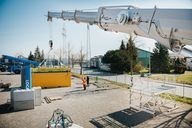Crane Interest Group
The Crane Interest Group was the original interest group and the largest of all the SIGs, commanding respect both in the UK and in Europe. Members of CIG were heavily involved in the writing of the British Standard 7121 series - Safe Use of Cranes and have also been continually involved in all of the many revisions which have subsequently taken place.
CIG further helped produce CPA Contract Lifting Services Conditions to be used both for Contract Lifts and machine moving operations and helped produce the Supplementary Conditions for crane hire to use in conjunction with the CPA Model Conditions for the Hiring of Plant.
CIG were further heavily involved in the drafting of revisions to the STGO regulations with the Department for Transport, enabling mobile cranes to travel with higher axle loadings and at more realistic road speeds, and continually introduce new and updated versions of their series of safety publications and technical information notices, giving guidance both to the crane rental companies and their customers.
CIG has a steering group and holds an annual open meeting for industry and is currently Chaired by Peter Gibbs from Ainscough Crane Hire Ltd, who continues to undertake dialogue with CIG members to ascertain group priorities and objectives.
The Crane Interest Group through the CPA are also members of ESTA. More information can be found using the link below.
CAA Airfield Crane Notification System
The Civil Aviation Authority (CAA), the aviation regulator, has introduced a new notification system to help the construction industry in notifying airspace users of cranes above a specified height. Their Airspace Co-ordination Obstacle Management Service (ACOMS) portal will help those planning flights and drone activity to assess any risks and plan appropriately. In essence, notification is required if a crane is:
- to be used within 6 Km of the aerodrome/airfield and its height exceeds 10 metres Above Ground Level (AGL) or that of surrounding structures or trees, if higher, or;
- is to be operated at or above a height of 100 metres AGL regardless of location or height of surrounding structures.
The CAA recommends using ACOMS at least eight weeks before the erection of the crane, however, as the CAA recognises that there are times when very little notice is given to the crane user, additional notification timescales have been created as follows:
PLANNED LONG-TERM PROJECTS: Notification to be sent to the CAA at least eight weeks (40 working days) before the erection of the crane. The CAA will then identify parties that may be affected by the crane and inform the crane user and affected parties about the next steps.
AD-HOC PROJECTS: Notification to be sent to the CAA not later than 5 working days in advance. The CAA will then identify parties that may be affected by the crane and inform the crane user and the affected parties about the next steps.
UNFORESEEN AND URGENT PROJECTS: If there is an unforeseen and urgent requirement to erect a crane within 5 working days from the notification, the crane user is required to contact all aerodromes whose perimeters are within 10 Nautical Miles (NM) (18.5 km) of the crane and submit the notification via ACOMS as soon as possible and advise which aerodrome operators have been contacted and the reason for less than 5 working days’ notice.
Where cranes are to be in situ for more than 90 days, before the crane is erected, users must also notify:
- the CAA by the ACOMS Service, and;
- the Defence Geographic Centre (DGC)
The lighting requirements are the same as previous CPA communications, being:
- Above 150 metres - must be illuminated with 2000 candela;
- Within 6 Km of aerodrome as dictated by aerodrome operator;
- 45 metres to 150 metres - recommend 2000 candela;
- Less than 45m - recommend 32 candela.
If the crane is within the vicinity of an aerodrome AND 100m or higher above ground level, users need to notify both the aerodrome and the CAA via ACOMS. If the crane is in the vicinity of an aerodrome AND 100m or higher above ground level AND in situ for more than 90 days, you need to notify the aerodrome, the CAA and the DGC, as described above.
It is the hirer of the crane (principal or other contractor) who is ultimately responsible for notifying relevant aerodromes and the lighting of the crane. Crane suppliers should ensure that hirers are aware of this requirement.
The CAP 1096 publication - Guidance to Crane Users is in the process of being revised and CAA advise that at least three-months notice will be provided prior to the full implementation of CAP 1096. More information on ACOMs and other notification requirements and how to register to submit notifications is at: https://www.caa.co.uk/commercial-industry/airspace/event-and-obstacle-notification/crane-notification/

